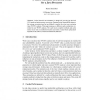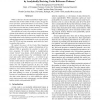346 search results - page 3 / 70 » Worst-case execution time analysis for a Java processor |
ISOLA
2010
Springer
13 years 5 months ago
2010
Springer
In object oriented languages, dynamic memory allocation is a fundamental concept. When using such a language in hard real-time systems, it becomes important to bound both the worst...
RTAS
1996
IEEE
13 years 11 months ago
1996
IEEE
Recent progress in worst case timing analysis of programs has made it possible to perform accurate timing analysis of pipelined execution and instruction caching, which is necessa...
OTM
2004
Springer
14 years 23 days ago
2004
Springer
Cache memories are mandatory to bridge the growing gap between CPU speed and main memory access time. Standard cache organizations improve the average execution time but are diffi...
RTAS
2005
IEEE
14 years 1 months ago
2005
IEEE
While caches have become invaluable for higher-end architectures due to their ability to hide, in part, the gap between processor speed and memory access times, caches (and partic...
WCET
2008
13 years 8 months ago
2008
TUBOUND is a conceptually new tool for the worst-case execution time (WCET) analysis of programs. A distinctive feature of TUBOUND is the seamless integration of a WCET analysis c...


